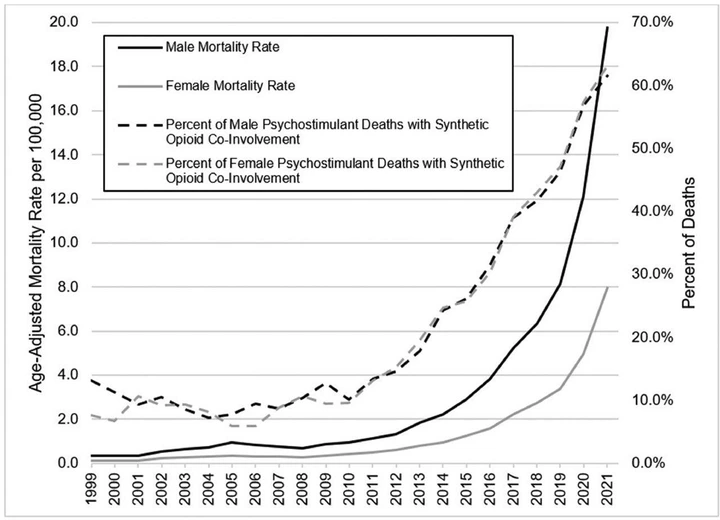
View pictures in App save up to 80% data.
A study reveals that methamphetamine-related fatalities in the United States surged 61 times between 1999 and 2021, underscoring an escalating epidemic of addiction and public health concerns.
Analyzing the gender distribution of these fatalities could enhance harm-reduction strategies and patient outcomes for those dealing with addiction, according to Andrew Yockey, an assistant professor of public health at the University of Mississippi and co-author of the research.
"According to Yockey, our research indicates that men tend to use nearly all substances, with the exception of tranquilizers, more frequently than women. This trend holds true in our findings as well. Notably, when it comes to methamphetamine, we observe that women generally achieve better treatment results, while men are less inclined to pursue treatment options."
"Therefore, if we genuinely focus on creating interventions with this perspective, we can be confident that we'll enhance these results."
Yockey and Rachel Hoopsick, assistant professor of health and kinesiology at the University of Illinois at Urbana-Champaign, published the team's findings on gender differences among methamphetamine deaths in the American Journal of Preventive Medicine. Their goal is to influence policy and highlight the ongoing crisis of methamphetamine-related fatalities in the United States.
"According to Hoopsick, there has been a dramatic rise in methamphetamine-related deaths among individuals aged 15 to 74 in the United States, affecting both men and women. Nevertheless, our research indicates that the gap in methamphetamine mortality rates between genders may be closing."
"We're not seeing a reduction in the gap due to declining mortality rates in men, but rather due to the rising mortality rates among women."
From 1999 to 2021, the incidence of male fatalities linked to methamphetamine increased by 58.8 times, while female fatalities surged by 65.3 times, resulting in a reduced difference in the annual total deaths associated with the drug.
According to Yockey, the most significant increase occurred between 2019 and 2021, which can be attributed not only to the COVID-19 pandemic but also to the growing presence of synthetic opioids among methamphetamine users.
Synthetic opioids like fentanyl, carfentanil, and xylazine are more accessible and simpler to produce. Their combination with methamphetamine significantly increases their lethality.
The percentage of fatalities among men who were simultaneously using methamphetamine and heroin or synthetic opioids increased from 13.1% to 61.5% during the years analyzed by the researchers.
"While it seems that opioid consumption has decreased in recent years, what we're really witnessing is the emergence of synthetic opioids," he stated. "We're beginning to observe that fundamental drugs like methamphetamine are being mixed with synthetic opioids."
"When we observe cases of overdoses and poisonings, the overwhelming majority involve multiple substances."
According to the Mississippi Department of Health, drug overdose fatalities surged by 182% from 2011 to 2021. During this decade, deaths linked to synthetic opioids skyrocketed from 16 to 474, marking an almost 30-fold rise.
The researchers emphasized that the significant rise over the past twenty years, along with the differences in substance use between genders and the interplay with other substances, underscores the urgent necessity for enhanced harm-reduction initiatives.
"Harm reduction is a topic we discuss in the U.S., but our implementation leaves much to be desired," Yockey expressed. "Programs for needle exchange, providing clean needles, and creating supervised spaces—these initiatives cater to individuals who choose to use drugs but aim to do so in a safer manner. I would really like to see increased initiatives like this in Mississippi."
Harm-reduction strategies have significantly decreased the rates of death and the spread of bloodborne illnesses like HIV in Europe, yet these approaches have not been broadly embraced or put into practice in the United States.
"By gaining a deeper insight into the differences between sexes regarding substance use behaviors and the reasons behind them, we can develop more targeted intervention and prevention strategies," Hoopsick remarked. "This could encourage U.S. policymakers to adopt a harm-reduction strategy instead of the current system, which often emphasizes punitive measures that impose severe legal consequences for substance use."
According to Hoopsick, unlike various other harmful substances, there is currently no FDA-approved medication available to assist individuals in withdrawing from stimulants like methamphetamine. This absence of support for methamphetamine users further reinforces the researchers' conviction regarding the importance of implementing harm-reduction strategies.
"People have access to highly effective medications for managing alcohol use disorder or opioid use disorder, which can significantly help reduce cravings. These are powerful resources to utilize. However, we lack similar options for addressing cravings related to stimulants," she explained. "Therefore, it’s not as straightforward as simply prescribing a medication and expecting everything to be resolved."
"Harm reduction focuses on connecting with individuals at their current stage and ensuring they are not overlooked."
Yockey, Hoopsick, and Hannah Allen, who serves as the executive director of the William Magee Institute for Student Wellbeing and is also an assistant professor of public health at the University of Mississippi, are set to investigate the connection between methamphetamine use and suicide rates across ten rural counties in Mississippi.
Yockey stated that the team will collaborate with advocacy organizations and local partners in those areas to evaluate their needs and offer resources whenever feasible.
"This initiative will enable us to achieve several objectives," he explained. "Firstly, it will help us gather both quantitative and qualitative data. Additionally, it provides an opportunity to collaborate with narcotics agencies, community organizations, and academic medical institutions. Ultimately, our goal is to decrease methamphetamine usage and enhance treatment options for individuals at risk of suicide in Mississippi."
More information: Tonazzina H. Sauda et al, Sex Differences in Methamphetamine Mortality in the United States: Heroin and Fentanyl Coinvolvement, 1999–2021, American Journal of Preventive Medicine (2024). DOI: 10.1016/j.amepre.2024.10.012
Supplied by the University of Mississippi
This story was originally published on Medical Xpress. Subscribe to our newsletter for the latest sci-tech news updates.









